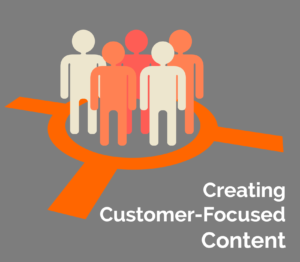 I’m a lucky guy. In my career I’ve held a variety of positions: operations manager, marketing director, director of business development, customer success manager, regional sales manager. Each of these has given me a slightly different angle on how to approach a business problem, and I’ve come to see how to synthesize a solution that can meet the needs of many departments. Often that solution takes the form of customer-focused content.
I’m a lucky guy. In my career I’ve held a variety of positions: operations manager, marketing director, director of business development, customer success manager, regional sales manager. Each of these has given me a slightly different angle on how to approach a business problem, and I’ve come to see how to synthesize a solution that can meet the needs of many departments. Often that solution takes the form of customer-focused content.
I spend a lot of my time helping companies develop content marketing campaigns. At some point, I always end up having to make the same point in nearly all of these efforts: Stop trying to advertise in your content marketing.
We all know about content marketing. As Anne Murphy of Kapost notes, “Today, customers have more control over their buyer experience than ever before. They research their purchases thoroughly (and independently), gathering information from various channels and resources. This information comes in the form of marketing content, and guides them through every step of their journey from first touch through advocacy.”
But the core concept – content is about the customer’s needs, wishes, hopes – seems to elude most of us. As marketers, we’re confident in our ability to write good copy, develop compelling images, and leverage technology. However, too often we are driven by one overarching fear – “They won’t get it.”
This fear drives the wrong priorities, and makes us short-sighted. We end up talking too much, and overreaching in our various mediums for fear that we’ll lose the audience’s attention before we have a chance to get good leads to sales. We overreach, under-qualify, and send the wrong people to talk to our sales team. We spew information about our product or service and call everyone who interacts with it “qualified.”
Frankly, this ruins the experience for our audience and costs us the relationship. (And scuttles second chances, too.)
The origins of content marketing
Content marketing is nothing new; it’s a very old practice, dressed up in a new, buzz-worthy name. A prime example: In the US, in 1895, the John Deere company began to produce “The Furrow,” a magazine published for farmers. It didn’t focus on available machines; it wasn’t a catalog. It did focus on how the farmer could be more successful, through best practices of all kinds, whether those had to do with machinery or not. It focused on what the farmer needed to know to run a better business and become more profitable. It was about the customer, not the product. It helped John Deere become a trustworthy, and trusted, name. (And it didn’t hurt that the actual machines were first-class. For those of you not from a rural community, “Nothing runs like a Deere.”)
 Powerful search engines have put the much of human knowledge (good, and bad) at the fingertips of our buyers, who pick up a mouse when they want to buy something – not a telephone. They are looking for answers and solutions (which we call products and services). They often find them (or a class of them) on the net, through advertising and landing pages and videos and such. The most trustworthy, believable material they find is customer-focused content marketing. Marketers compete to provide meaningful solutions and earn a chance at a sales conversation. But so often we do it wrong. I recall my first attempt at content marketing copywriting …
Powerful search engines have put the much of human knowledge (good, and bad) at the fingertips of our buyers, who pick up a mouse when they want to buy something – not a telephone. They are looking for answers and solutions (which we call products and services). They often find them (or a class of them) on the net, through advertising and landing pages and videos and such. The most trustworthy, believable material they find is customer-focused content marketing. Marketers compete to provide meaningful solutions and earn a chance at a sales conversation. But so often we do it wrong. I recall my first attempt at content marketing copywriting …
I was in the flooring industry and our VP of Marketing had asked me to write an article for a local home decor magazine in San Diego County. I read every single article in the magazine, and confident I had the concept down, I wrote my 800-word article on “The Value of Stone Floors During Your Home’s Appraisal.” I left a printed copy, along with the magazine I had reviewed, on my boss’s desk. About 20 minutes later, I was working on something else, peacefully listening to my headphones when a magazine came flying from nowhere and hit me in the head.
“Did you even READ the articles in this magazine?!” my boss shouted.
Was he rude? It doesn’t matter; he was right. You see, I had missed the point entirely. My 800 words could be summed up as various iterations of “You want stone? We sell stone! Stone is awesome and we sell it, and we’re the best at selling it.”
I thought I’d written an article, but I had written an ad. I’d missed the memo, and didn’t know the difference.
The Rules for Good Content
1. Focus on your buyer
Understand that this isn’t about you. Your buyer is attempting to quantify a need or solve a pain. They are looking at your content from their vantage point – and their vantage point has nothing to do with your revenue goals. They are looking for a solution, or help in defining a problem and solution. That should be your focus. When I wrote that story about how stone floors help in raising your home’s appraisal value, I should have focused on what the homeowner needed to know about getting ready for an appraisal. That would have had value to the reader and positioned my company as a trustworthy vendor who cared about their customers … instead of being an ad for stone floors.
Who is your buyer and what do they want to learn?
2. Focus on the initial cause of the need
Why would your audience give you their attention? As you define that initial cause, focus in on it. Feel it and write to it. If the initial need or pain can be summarized or quantified, do so. Provide options in your solutions. Help the reader to feel like you understand, that you’ve walked in their shoes.
Be a beggar telling another beggar where you found bread.
3. See it as a relationship, not a transaction
This is a relationship. You’re asking for attention from someone who can do you good. It’s going to take time to convince them that there’s a benefit for them as well. You have to build trust, earn confidence, and impress. As you build the relationship, invite them to move through a process with you.
Earn the right to ask for their business.
Content Marketing Isn’t Advertising
If we all agree that the Content Marketing Institute is an authority (I certainly do), then let’s look at their definition of content marketing:
Content marketing is a strategic marketing approach focused on creating and distributing valuable, relevant, and consistent content to attract and retain a clearly-defined audience — and, ultimately, to drive profitable customer action.
And they go on to say:
Basically, content marketing is the art of communicating with your customers and prospects without selling. It is non-interruption marketing. Instead of pitching your products or services, you are delivering information that makes your buyer more intelligent. The essence of this content strategy is the belief that if we, as businesses, deliver consistent, ongoing valuable information to buyers, they ultimately reward us with their business and loyalty.
(The bold type is my emphasis.)
Characteristics of Advertising
 Advertising is inherently self-promotional. It discusses product features, the benefits of a specific service, or the advantages of a solution you provide. On the other hand, content marketing discusses ideas, strategies, and information. While these may have some relation to what your product or service does, it’s just as likely to be on another topic. And it is not, repeat not, self-promotional.
Advertising is inherently self-promotional. It discusses product features, the benefits of a specific service, or the advantages of a solution you provide. On the other hand, content marketing discusses ideas, strategies, and information. While these may have some relation to what your product or service does, it’s just as likely to be on another topic. And it is not, repeat not, self-promotional.
Just as an artist gains popularity by creating good art, so your company or brand benefits by creating good content. By discussing the right topics, you gain the right audience. By providing the right information, you gain the trust of that audience. By gaining their trust, you (eventually) earn the right to ask for their business. And you have to trust them to “get it.” What they’re getting is not the facts about your product; it’s whether they see you as someone who’s interested enough in their success to help them in multiple ways. Whether they see you as someone they want to work with … or someone who’s just self-interested.
A Real-Life Example
A good blog post that helps to define a problem is a great place to promote a whitepaper that helps solve the problem. Downloading that whitepaper can trigger an email campaign that invites them to discuss their challenge with you, and your sales team can insert themselves as a consultative resource.
Here’s how that might play out:
- If you’re reading this, you most likely care about content marketing.
- At the bottom of this post, there is a call to action for an eBook about content marketing.
- If you like the look of the eBook, and you trust Act-On to some degree, you might be inspired to fill out a form that will give you the eBook, and tell us how to contact you.
- We would then send a few emails to gauge whether or not you’re interested in marketing automation, and if so, how interested.
- If you’re interested in content marketing but not in marketing automation, that will show in your interaction with our materials. You won’t become a qualified prospect, and no salesman will call.
- Say you are strongly interested, and you want to see a demo. We’ll connect you with our sales team, and they’ll show you the platform and answer your questions.
If you are genuinely interested in marketing automation, and you trust Act-On, you could become a qualified prospect for our product – all because of a blog post.
Whether or not you’re interested in marketing automation, we’ve got more great information to share about content marketing. Check out our free toolkit: 4 Steps to Develop a Content Plan, which contains the resources you need to create content that attracts prospective buyers and creates brand affinity.
And as a bonus, here is an awesome infographic on the history of content marketing from CMI.
